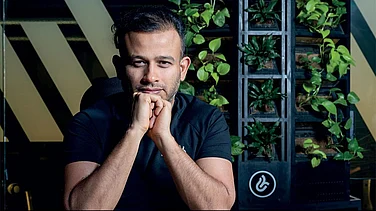With 85% of quick commerce gross merchandise value (GMV) still concentrated in India’s top six metros, expanding profitably into Tier-2 and Tier-3 cities continues to be a significant challenge. Manan Bhasin, Partner at Bain & Company, says that lower order density, wider delivery catchments, and smaller basket sizes weigh heavily on unit economics in smaller towns. This in turn, makes the 10-minute delivery promise harder to fulfil and less sticky for consumers.
“Now, when we look beyond these top or Tier-2 cities that you specifically spoke about, the biggest thing is that the order density is lower, purchase frequency is lower, and the spend per order could also be lower. And all of these things could adversely impact the unit economics,” says Bhasin.
Hitting the sweet spot of 1,000+ daily orders per dark store is essential for viability, he explains, but in smaller cities, stores often have to serve a much wider catchment, up to 6–8 kilometres compared to 2–3 in metros.
In a conversation with Outlook Business, Vijay Iyer, Vice President and General Manager of Flipkart Ads, and Manan Bhasin, Partner and leading member of the Consumer Products & Retail practice at Bain & Company, share insights on how India’s quick commerce ecosystem is evolving. Bhasin points out that India’s quick commerce players are seeing improved profitability, with stronger unit economics, higher basket sizes, better margins, and denser order networks, though competitive intensity still keeps them in a burn phase.
Advertising, they says, is becoming increasingly central to brand strategy, with platforms like Blinkit and Swiggy earning 4.5–5% of order value from ads. Brands are not just chasing visibility but looking for relevance, with AI playing a key role in creating personalized and native ad experiences.
Edited Excerpts
Given that 85% of q-commerce GMV still comes from the top six metros, what challenges do you foresee in scaling q-commerce profitably in Tier-2 and smaller cities?
Manan Bhasin
Most of these quick commerce players are today present well beyond those top six cities. So, I think if you look at the latest filings, they're talking about up to 20 cities, right? And many of these have, in fact, turned profitable, but the scale is deepest in those top six cities because that's where the focus has been.
Now, when we look beyond these top or the tier-two cities that you specifically spoke about, the biggest thing is that the order density is lower, purchase frequency is lower, and the spend per order could also be lower. And all of these things could adversely impact the unit economics. If you really think about it, the unit economics are driven by hitting that order density sweet spot of 1,000 orders per day or more than that. The minute the order density is going to be lower than that, the same dark store is going to have to cater to a wider catchment, which means that typically versus catering to a two to three kilometer catchment, they'll end up catering to a six to eight kilometer catchment.
Now, that obviously has an implication on the speed of delivery. So, instead of delivering within 10 minutes, it may end up delivering in 20 to 30 minutes, making it less sticky as a proposition. Now, this is not to say that it can't be solved or it can't be done.
All I think at least that we are in a position to say right now is that it's not been proven at scale. There are experiments in place, there are areas where it has worked, but we just need to see it more at scale right now. All of these players are aggressively scaling up in these smaller cities to make this happen.
Given that players like Swiggy and Zomato are prioritizing expansion over profits, do you think this cash-burning model is sustainable in the long run?
Manan Bhasin
I don't necessarily think that it's fair to say that they've not managed profitability, the EBITDA positions for all of these players have actually improved over time. I mean, if I just look at the unit economics for the top, say, Blinkit for example, they've demonstrated substantial improvement in the unit economics of the business.
And across players, what we've seen is that basically three or four different things have contributed to improved profitability. One, the basket size or average order value has increased by 20 to 30 percent. Number two, the gross margins have improved by two to five percentage points.
I'm comparing FY25 exit to FY23 exit. Then the cost per shipment has also come down, which is reflected in SG&A, direct process, etc. And the reason for that is the increase in order density.
Actually, I do think profitability has improved, many of the dark stores are currently operating profitably. That said, there is still a burn phase happening because competition is very fierce and intense.
India currently benefits from low rents and high population density, but as labour and real estate costs rise, do you think these advantages will remain sustainable in the long run?
Manan Bhasin
I think you're absolutely right in saying that India has some structural advantages . Whether it's our population density, which in the top eight cities is five times that of China, or lower rent, which is half of China’s, or manpower costs, which are just a fifth of China’s.
All of these structural factors have played a crucial role in making quick commerce work in India. But at the same time, we can’t underestimate or discount the category creation efforts made by the top players.
I wouldn't go so far as to say that the only advantage is cost. One of the most unique elements about India is how affordable manpower and lower-rent locations coexist with affluent populations. Just the way our cities are laid out with lower-income areas often right next to affluent neighborhoods, is a structural factor that has really helped quick commerce thrive here.
Even if real estate and labor costs rise, I believe these structural advantages will persist. And beyond that, there are several ongoing efforts aimed at improving profitability and unit economics.
The report also highlights the growing role of advertising. Many brands say that while initial ad spends on quick commerce or e-commerce platforms help with visibility, the costs can become unsustainable over time. How do you see this focus on advertising playing out?
Manan Bhasin
Has advertising increased on platforms over time? Yes. But typically, the way this happens is that there are more properties available for advertising, specifically for brands. Brands are interested in advertising, and for them, quick commerce is an incredibly important channel.
They actually want to stand out from their peers. If you look at the filing data for Blinkit and Swiggy, these platforms report that advertising contributes around 4.5 to 5% of the average order value. In search listings, top players are now showing about one sponsored listing for every five listings.
So, ads play a very important role in the brand journey. They help with discovery and allow smaller brands to stand out and gain market share. I don’t necessarily think this is a loss-making proposition for brands. It actually enables them to capture incremental spending.
It’s also something brands want to invest in. What we’re seeing is a shift in distribution channels over the past year. As a result, the way brands think about their ad spends has evolved quite significantly. Performance ads, for example, are now a very important category of spending, which wasn’t necessarily the case 20 years ago.
Ad formats are evolving rapidly with the rise of quick commerce and e-commerce. With brands now planning their ad budgets and strategies even before launch, how are you seeing this shift play out? And how is AI shaping your approach to advertising?
Manan Bhasin
The US is currently closer to around 30%. But again, when it comes to who is spending, the market structure between legacy brands and insurgent brands shifts and varies by category. Typically, categories like general merchandise or groceries are major contributors to ad spending. That’s why you see more advertising on quick commerce platforms. These are highly searched products, offering significantly more advertising opportunities than traditional banner ads or fixed slots.
Vijay Iyer
If you dial back 10 years, digital media was still evolving and there was no concept of retail media as such. Back then, organic reach and advertisements were often treated as separate, even mutually exclusive, strategies. That is no longer the case. Today, most ads are native to the customer experience. In this world of constant online presence and overwhelming choices, it's crucial for ads to be relevant and highly personalized.
Yes, you still need ads to stand out, to announce a product launch, for example. But as Manan pointed out, much of it now needs to be deeply integrated into the customer journey. That is where AI is already playing, and will continue to play, a significant role. We are now experimenting with hyper-personalization so that customers are shown products they are actually interested in.
The idea is to offer an experience-led selection and be relevant to the customer, rather than waiting for the customer to explicitly search for a product and go through a long discovery process. This is how 40% of shopping in India is happening today, especially among Gen Z. They know what they want, they want it fast, and they prefer to buy from brands they relate to. So it is not just about visibility, it is about relevance.
AI is already touching multiple areas. For example, for small sellers who may have a great product but lack the ability to create a video, we are experimenting with solutions that can automatically generate product videos using just their images. These videos can be used not only for ads but also for merchandising.
Read: Inside Flipkart’s Gameplan of Fighting the Quick Commerce War
How do brands and platforms today need to adapt differently for Gen Z shoppers, who tend to display more experimental behavior compared to other generations?
Vijay Iyer
So if you look at the How India Shops Online report, some of the key things you'll find are: 40 percent of India's online retail is now coming from Gen Z. They make up 40 percent of the base. Seventy percent of them want to discover brands online, they are spending more, and they are also interested in new-age fashion brands. They want to move fast and see the latest trends.
If you connect this to how we at Flipkart are thinking about the experience, we are already piloting initiatives, and you'll see a lot more of this in the weeks and months to come. There is going to be a strong push toward video-forward commerce. We want the experience to be very video-led and visual.
We are making the selection experience for Gen Z much more video-driven. The selection itself is very trend-driven, and this will continue to grow.
But most importantly, even with this massive selection and all the videos, personalization becomes crucial. We aim to show Gen Z customers exactly what we know they will like and what will resonate with them.
In many ways, we are shifting from a transaction-first approach to an experience-first approach. What we show is heavily video-based. Then we bring the customer closer to a curated selection that we know they will appreciate, and we make the purchase journey as simple as possible. Much of our Gen Z-focused catalog is also designed to be delivered faster.
Gen Z, as you know, is UPI-first, so payments are seamlessly integrated. Across the value chain, there are multiple factors coming together to create a differentiated and relevant experience for Gen Z.
Given China’s ad spend is around 50–55%, do you think India’s spend will follow a similar trajectory with the rise of quick commerce, or are we likely to plateau around 25%?
Manan Bhasin
Rather than over-indexing on specific numbers like 20%, 25%, or 50% for UPI, I’d focus more on where the ad spend is actually coming from. One of the big categories still largely unsolved in India is grocery. We’re still at sub-1% online penetration in grocery, even though it’s the largest component of retail consumption in the country. In China, grocery penetration looks very different. As online grocery penetration grows in India, I’d expect ad penetration to rise as well. That’s how I’d approach it.
Trend-first commerce is expanding beyond fashion into categories like electronics and beauty. Do you see any limits to how many brands can sustainably adopt this model?
Manan Bhasin
I think fashion has been kind of the first frontier when it comes to trend-first commerce. But we're seeing the role and importance of trends increase. What’s important to understand is that “trendy” is not always equal to fast refresh. We should clearly distinguish between the two.
Often in fashion, we talk about fast refresh cycles, shrinking the time from manufacturing or design to shelf. But what we began to see is that for many consumers, the role of trends was more important. This holds true across categories.
For example, in beauty, people talk about Korean skincare, nine-step routines, and so on. In electronics too, specific colors are being talked about. Consumers want those things today. One big factor behind this is how dramatically the dissemination of information across countries has changed because of social media.
As that has happened, trends travel much faster, and consumers want to experience them. That’s why we’re seeing an increase in trend-first commerce. It’s still more indexed to fashion, but it’s making a dent in other categories as well. That said, there will be limits to how far it can reach in certain categories—some are just not design-led. Categories that are more functional and spec-driven will remain so.
And the moment you mentioned social media and global exposure, I thought of Korean culture. My sister keeps dressing like them, eating like them.
Vijay Iyer
Fundamentally, it's about micro-trends. The Korean trend is far more palpable, but at the core, this is about spotting micro-trends. It’s data-led and time-sensitive. It's very brand-specific. I think the Korean trend influences many of us, so there might be a bias there. But it’s not just about a Korean trend emerging. Even when you're looking at micro-trends, it could be something as mundane as pressure cookers.
If you divide India into multiple regions, there are areas where it's not just about volume, but about the specifics—whether it’s stainless steel, indolium, or non-stick—that determine what’s going to work. Your ability to go to the brand and say, “Hey, there’s a surge or likely surge in this type of pressure cooker in this part of the country,” becomes a vital micro-trend insight. While that may not fall squarely under trend-first commerce, it’s still a trend. We need to be able to go to brands and explain why it’s happening, and they look to us for that kind of intelligence.
We’re seeing many global brands choosing to launch first through quick commerce or e-commerce platforms. Are these international brands approaching advertising or visibility differently compared to homegrown Indian brands
Manan Bhasin
I think what we've seen is that a lot of global brands have long wanted to be in the Indian market, but they also want to experiment to see if there’s really a market for them here. The answer to your question also varies based on price points and other factors. Many of these brands want to test the waters and understand whether it's worth investing deeper.
We actually saw a rise in such entries into India through online channels. This was especially pronounced in categories like beauty, where several global brands began with an online-first strategy before gradually scaling through traditional offline retail.
Vijay Iyer
I think brands entering India now do so with the understanding that the country isn't a monolith. It’s made up of many India’s. That realization is crucial. They no longer view India as just a collection of urban markets. They understand the complexity of tier 1, tier 2, and tier 3 cities.
So, when they enter, they typically look for partners who can help them decode this diverse market. When a brand says, “We want to establish ourselves in India,” it’s our job to help calibrate that ambition. We look at their product, price point, and explain what the market landscape looks like. Given Flipkart’s deep reach in tier 2 and tier 3 cities in addition to tier 1, we can help them have a more informed, localized strategy. That’s where the journey starts—decoding the many Indias and helping them build a tailored growth plan.
With tech advancing and the ‘many Indias’ insight gaining traction, are most brands truly aware of this complexity? Are they actively building region-specific ad strategies, or is that still limited to a few early movers?
Vijay Iyer
This is a very interesting point, because some of our advertising formats are inherently structured in a way, let's say, if you're doing something like display ads, you can do it in whatever region you want. And now there's a nice flywheel, right? Where if I'm able to go and tell someone, "Hey, you're a beauty brand and this water-based skincare range will probably work better in Kerala, and here is some data to support it," right? But increasingly, brands also want the lower-funnel ad products to be more and more regionally focused, to be more and more in color. It's a challenge.
For example, if I go and tell this beauty brand that their water-based products will do very well in Kerala (a humid place), they would normally gear their display ads towards that and run a campaign specifically in Kerala for display. But, search in general is more generic, right? It's when the customer is telling you that they're looking for something. And that's a challenge we see customers throwing at us often saying, "Hey, I'm ready to create this selection or curate this selection. Can you make your native ads also more regionally aware?" And that's a challenge we're working on. It's not that simple to solve because of the nature of search, but it's something that comes to us quite often.
Manan Bhasin
I think the concept of mini-India has been spoken about by big consumer product companies for many years. What’s different today is that we now have much faster data cycles, and the ability to segment insights more granularly—like what’s working in Kerala versus what’s working in the North, for example.
The more important shift is that there’s real value today in having these discussions with brand managers and platforms to understand how best to act on these insights.
A lot of interesting insights around new product development have emerged through this process—not just advertising alone. Take mixer grinders, for instance. High-wattage grinders perform very well in the South because of coconut chutney–based cooking, which is much more prominent there. Consumers want appliances that can handle that demand seamlessly.
So, products that came with detachable jars, which could be stored directly in the refrigerator, became very popular. Companies that picked up on that insight early were able to capture a larger market share.
Ultimately, it comes down to listening to the consumer and capturing insights from your channel. And I think the best brands, both legacy national brands and young insurgent ones, are doing that very well.
With all the buzz around AI, are brands increasingly expecting AI to play a role in their advertising strategies or campaign planning?
Manan Bhasin
I think the best founders are always thoughtful and mindful about disruption. They're conscious of the fact that AI is evolving. I wouldn't say people are being rash about it or force-fitting it either. Brands and founders seem to be approaching it with care, trying to prioritize where AI can actually add value. It’s not just about the hype, but more about asking—where does it make sense to use this?
Vijay Iyer
I have a slightly different take. If you drive a car, you may have heard of something called spot welding—it’s crucial for the car’s structural safety. But nobody really talks about it; they just talk about how safe the car is. Spot welding is done with robotic precision and advanced tech, yet it's in the background.
Similarly, responsible brand owners aren't always focused on the AI label. Instead, they ask how their ads can be more relevant, how creatives can be more impactful without overwhelming the customer. Should they use more lifestyle imagery? Are there certain colors to avoid? What makes a good creative better?
These are the kinds of problems that AI is increasingly helping to solve, sometimes even before they become visible issues. So to me, AI in advertising is like spot welding in cars: it powers the result, but it's not always the thing people talk about. They talk about impact, relevance, and effectiveness, not necessarily the AI doing the work behind the scenes.
How is Flipkart’s ad business growing? Which categories are doing better / growing fastest on ads?
Vijay Iyer
Flipkart’s ad business continues to grow as brands increasingly recognize adtech as an integrated part of their marketing strategy that fuels business growth. According to the Dentsu-E4M Digital Advertising report, the Indian advertising industry is expected to grow at 6.5% in 2025. There is a greater push for platforms offering full funnel solutions with the ability to measure ROI, powered by rich first-party data and closed-loop attribution, which is driving this scale up. Commerce-led advertising allows brands to move beyond awareness to influence actual purchase decisions in a high-engagement environment.
How are performance marketing spends of brands evolving category wise?
Vijay Iyer
Marketing spends are shifting towards value creation rather than pure investment. Brands are adopting a strategy-first mindset, treating advertising as a must-have to ensure that their marketing comes full circle and drives both awareness and purchase. Flipkart provides a unified, high-intent ecosystem that helps brands overcome the fragmentation of traditional digital channels, allowing them to drive measurable outcomes at scale.
How are brands today allocating their ad spends between e-commerce platforms, social media, and streaming services—and what’s driving these choices?
Vijay Iyer
The rise of digital media has brought in sharper targeting and better attribution, but even today, most digital channels are optimized for top-funnel metrics like views or clicks. What’s more, the ecosystem remains fragmented, different publishers operate in silos, and cross-platform synergies are often limited, leaving brands with disjointed strategies and suboptimal results.
E-commerce as a publisher changes that equation. We offer a full-funnel solution within a single, high-intent environment—where discovery, consideration, and purchase can happen seamlessly. What sets us apart is the ability to deliver not just performance, precision, and accountability, but to do so at scale. With rich first-party data, high-engagement formats, and closed-loop measurement, brands can engage millions of consumers where they're actively shopping—blending storytelling with real outcomes. It's this unique combination of depth, integration, and scale that's making commerce-led advertising a core part of the modern media mix.



























